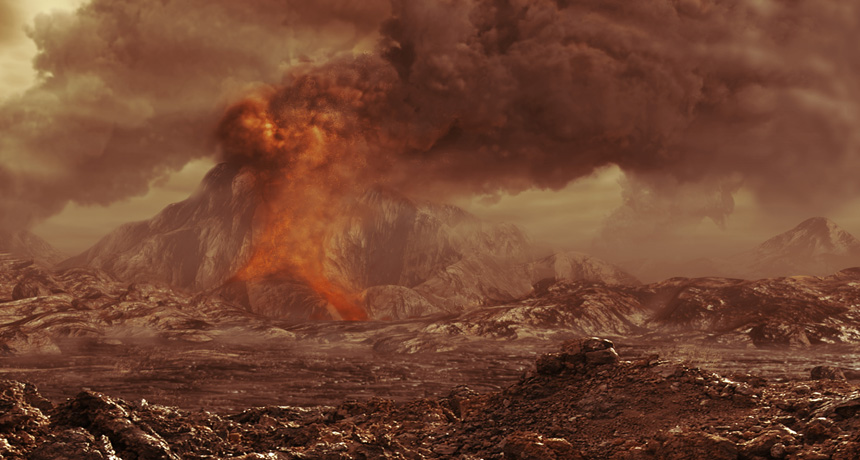News Brief: Venus may have active volcanoes
Flashes of infrared light may be evidence of hot lava

Flashes of infrared light detected by the Venus Express spacecraft could be signs of active volcanoes (illustrated) on Venus.
AOES MEDIALAB, ESA
Venus is sometimes called Earth’s twin. That’s because the planet is a similar size to our home. It’s also made of similar stuff. And like Earth, Venus may have active volcanoes, scientists now report.
The second planet from the sun hides beneath a thick atmosphere. That has made spotting volcanic activity difficult. New observations from the Venus Express spacecraft may be evidence of volcanoes erupting on the planet. That’s the conclusion of researchers in a study published June 17 in Geophysical Research Letters.
Venus Express orbited Venus from 2006 until last year. During its mission, the robotic spacecraft detected flashes of infrared light coming from the planet’s surface. Hot objects typically emit infrared waves. That led researchers to conclude the infrared light could be coming from fresh lava. Spacecraft observations showed hot spots rapidly heat up. Later, they cooled down. These bursts happened in a region of Venus riddled with fractures. Similar cracks open up around volcanoes on Earth.
Earlier missions to Venus offered other clues to its volcanism. One mission, called Magellan, was able to peer through the planet’s clouds. It spotted mountains that looked like volcanoes. And it found evidence that lava had flowed onto the planet’s surface sometime in its past. The Pioneer Venus Orbiter, another mission to the planet, detected sulfur dioxide spikes in its atmosphere. Those spikes hinted at modern-day volcanism. Sulfur dioxide (SO2) is a common gas spewed by Earth volcanoes.
The evidence of active volcanoes on Venus is growing. If lava is erupting on its surface, Venus would be the third world in the solar system known to be volcanically active. The other two are Jupiter’s moon Io and, of course, Earth.
Power Words
(for more about Power Words, click here)
atmosphere The envelope of gases surrounding Earth or another planet.
fracture (noun) A break. (verb) To break something and induce cracks or a splitting apart of something.
infrared light A type of electromagnetic radiation invisible to the human eye. The name incorporates a Latin term and means “below red.” Infrared light has wavelengths longer than those visible to humans. Other invisible wavelengths include X rays, radio waves and microwaves. It tends to record a heat signature of an object or environment.
Jupiter (in astronomy) The solar system’s largest planet, it has the shortest day length (10 hours). A gas giant, its low density indicates that this planet is composed of light elements, such as hydrogen and helium. This planet also releases more heat than it receives from the sun as gravity compresses its mass (and slowly shrinks the planet).
lava Molten rock that comes up from the mantle, through Earth’s crust, and out of a volcano.
moon The natural satellite of any planet.
orbiter A spacecraft designed to go into orbit, especially one not intended to land.
planet A celestial object that orbits a star, is big enough for gravity to have squashed it into a roundish ball and it must have cleared other objects out of the way in its orbital neighborhood. To accomplish the third feat, it must be big enough to pull neighboring objects into the planet itself or to sling-shot them around the planet and off into outer space. Astronomers of the International Astronomical Union (IAU) created this three-part scientific definition of a planet in August 2006 to determine Pluto’s status. Based on that definition, IAU ruled that Pluto did not qualify. The solar system now consists of eight planets: Mercury, Venus, Earth, Mars, Jupiter, Saturn, Uranus and Neptune.
solar system The eight major planets and their moons in orbit around the sun, together with smaller bodies in the form of dwarf planets, asteroids, meteoroids and comets.
sulfur dioxide A pollutant made of sulfur and oxygen that forms when fossil fuel is burned. Also a gas naturally emitted during volcanic eruptions. Its scientific symbol is SO2.
Venus The second planet out from the sun, it has a rocky core, just as Earth does. However, Venus lost most of its water long ago. The sun’s ultraviolet radiation broke apart those water molecules, allowing their hydrogen atoms to escape into space. Volcanoes on the planet’s surface spewed high levels of carbon dioxide, which built up in the planet’s atmosphere. Today the air pressure at the planet’s surface is 100 times greater than on Earth, and the atmosphere now keeps the surface of Venus a brutal 460° Celsius (860° Fahrenheit).
volcanism The processes by which volcanoes form and change over time. Scientists who study this are known as volcanologists and their field of science is known as volcanology.
volcano A place on Earth’s crust that opens, allowing magma and gases to spew out from underground reservoirs of molten material. The magma rises through a system of pipes or channels, sometimes spending time in chambers where it bubbles with gas and undergoes chemical transformations. This plumbing system can become more complex over time. This can result in a change, over time, to the chemical composition of the lava as well. The surface around a volcano’s opening can grow into a mound or cone shape as successive eruptions send more lava onto the surface, where it cools into hard rock.







